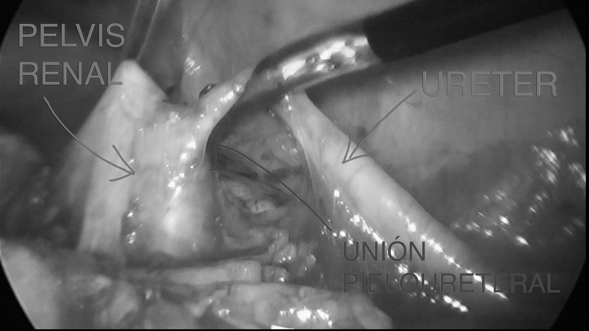Laparoscopic transperitoneal approach: choice in the correction of pyeloureteral stenosis in the pediatric horseshoe kidney
Main Article Content
Abstract
Background: Horseshoe kidney (HR) is associated in 33% of cases with pyeloureteral stenosis (UPE), for which reconstruction is required, without the need to divide the isthmus; currently, a transition towards laparoscopic management is taking place. Case report: male with a prenatal diagnosis of left hydronephrosis, persistent finding in the postnatal stage, in addition to confirmation of fusion of the lower renal poles (horseshoe kidney), in follow-up, an obstructive pattern was observed in uroresonance, transabdominal pyeloplasty was performed laparoscopically without complications. Discussion: the minimally invasive approach for performing pyeloplasty is a relatively new technique, with few reports in the pediatric population and reports in non-orthotopic kidneys. Conclusion: the transperitoneal laparoscopic approach for horseshoe kidney pyeloplasty provides adequate visualization of the structures and workspace, allowing a high success rate and safety.
Downloads
Article Details

This work is licensed under a Creative Commons Attribution-NonCommercial-NoDerivatives 4.0 International License.
Creative Commons
License Attribution-NonCommercial-ShareAlike 4.0 International (CC BY-NC-SA 4.0)
You are free to:
Share - copy and redistribute the material in any medium or format.
Adapt - remix, transform, and build upon the material The licensor cannot revoke these freedoms as long as you follow the license terms.
• Attribution — You must give appropriate credit, provide a link to the license, and indicate if changes were made. You may do so in any reasonable manner, but not in any way that suggests the licensor endorses you or your use.
• NonCommercial — You may not use the material for commercial purposes.
• ShareAlike — If you remix, transform, or build upon the material, you must distribute your contributions under the same license as the original.
• No additional restrictions — You may not apply legal terms or technological measures that legally restrict others from doing anything the license permits.
References
Hsi-Yang W, Howard M, Snyder III. Developmental and Positional Anomalies of the Kidneys. En: Holcomb and Ashcraft’s Pediatric. 7 Ed. Philadelphia: Saunders/Elsevier; 2020. p. Saunders/Elsevier.
Chertin B, Puri P. Pyeloplasty. En: Pediatric Surgery. Alemania: Springer; 2014. p. 485-92.
Carpentier X, Amiel J. Síndrome de la unión pieloureteral en el adulto: tratamiento quirúrgico a cielo abierto. EMC – Urol. 2008;40(3):1-9. DOI: https://doi.org/10.1016/S1761-3310(08)70041-0
Restrepo JHM, Ceballos MM, Sabaleta TIR, López AL, Toscano CAO. Anomalías de la rotación y la fusión renal. Rev Colomb Radiol. 2013;24(3):3751-5.
Hsu THS, Presti JC. Anterior extraperitoneal approach to laparoscopic pyeloplasty in horseshoe kidney:a novel technique. Urology 2003;62(6):1114-6. DOI: https://doi.org/10.1016/j.urology.2003.07.003
Sedláček J, Kočvara R, Molčan J, Dítě Z, Dvořáček J. Transmesocolic laparoscopic pyeloplasty in children: A standard approach for the left-side repair. J Pediatr Urol. 2010;6(2):171-7. DOI: https://doi.org/10.1016/j.jpurol.2009.06.010
Taghavi K, Kirkpatrick J, Mirjalili SA. The horseshoe kidney: Surgical anatomy and embryology. J Pediatr Urol. 2016;12(5):275-80. DOI: https://doi.org/10.1016/j.jpurol.2016.04.033
Blanc T, Koulouris E, Botto N, Paye-Jaouen A, El-Ghoneimi A. Laparoscopic Pyeloplasty in Children with Horseshoe Kidney. J Urol. 2014;191(4):1097-103. DOI: https://doi.org/10.1016/j.juro.2013.10.059
Esposito C, Masieri L, Blanc T, Manzoni G, Silay S, Escolino M. Robot-assisted laparoscopic pyeloplasty (RALP) in children with horseshoe kidneys: results of a multicentric study. World J Urol. 2019;37(10):2257-63. DOI: https://doi.org/10.1007/s00345-019-02632-x
Blanc T, Muller C, Abdoul H, Peev S, Paye-Jaouen A, Peycelon M, et al. Retroperitoneal Laparoscopic Pyeloplasty in Children: Long-Term Outcome and Critical Analysis of 10-Year Experience in a Teaching Center. Eur Urol. 2013;63(3):565-72. DOI: https://doi.org/10.1016/j.eururo.2012.07.051
Wang P, Xia D, Ma Q, Wang S. Retroperitoneal Laparoscopic Management of Ureteropelvic Junction Obstruction in Patients with Horseshoe Kidney. Urology. 2014;84(6):1351-4. DOI: https://doi.org/10.1016/j.urology.2014.07.029





